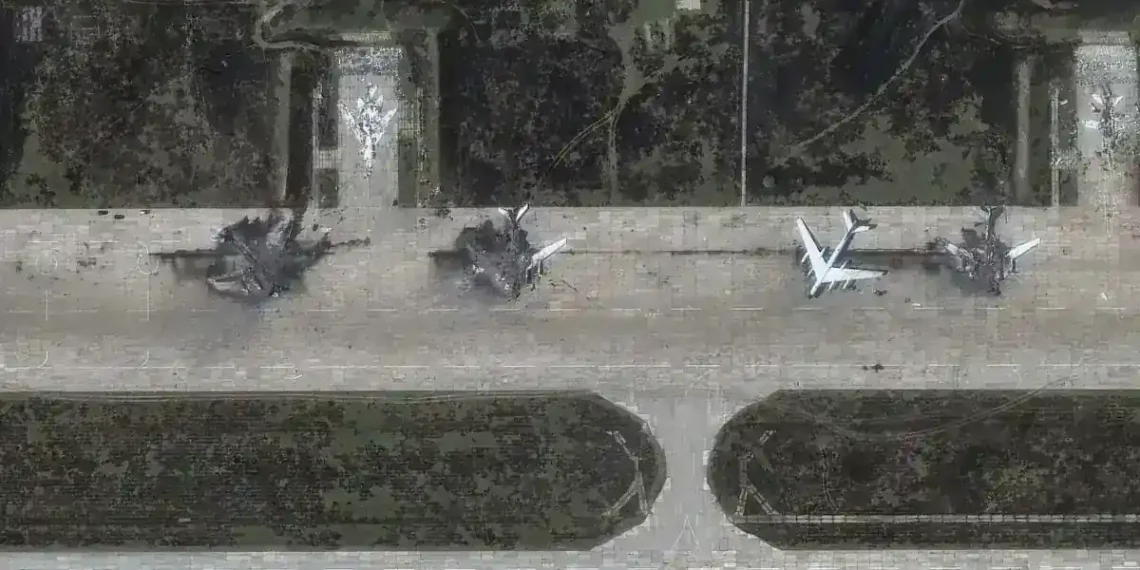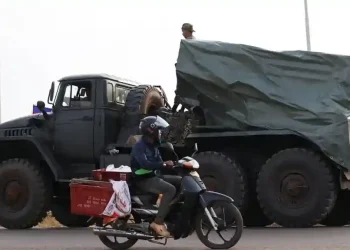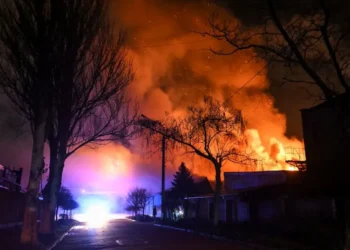Satellite Images Reveal Russian Bombers Destroyed in Bold Ukrainian Drone Strike
In one of the boldest covert operations of the war so far, Ukraine claims it has taken out 41 Russian warplanes in a sweeping drone strike—including strategic bombers parked deep in Siberia. Now, newly released satellite images appear to back up at least part of that claim.
Analyzed by The Associated Press, the satellite photos from Planet Labs PBC show seven Russian bombers visibly destroyed at Belaya Air Base, a key military hub for Russia’s long-range bomber fleet in eastern Siberia. The aftermath is unmistakable: burnt-out aircraft shells, scorched tarmac, and heavy blackened debris.
Among the wreckage:
- At least three Tu-95 “Bear” bombers, Cold War-era aircraft known for their long intercontinental range
- And four Tu-22M supersonic bombers, workhorses of Russia’s air-launched cruise missile attacks on Ukraine
Other aircraft parked nearby appear undamaged, suggesting the drone strike was highly targeted and surgical.
A Daring Strike Planned Over 18 Months
Ukrainian officials say this operation was 18 months in the making—a long-term effort to undermine Russia’s ability to wage air attacks, particularly those launched from deep within its borders. Sunday’s drone strikes reportedly hit multiple Russian airfields, including those in:
- Irkutsk (eastern Siberia)
- Murmansk (in the Russian Arctic)
- The Amur region (Russian Far East)
- And attempted strikes in western Russia, which Moscow claims were repelled
Russia’s Defense Ministry admitted that “several aircraft caught fire”, but downplayed the damage, saying the blazes were quickly extinguished. The Kremlin, meanwhile, has stayed silent—President Vladimir Putin has not publicly commented on the strike.
What Makes These Bombers So Important
The Tu-95 is no ordinary aircraft. Known for its distinctive turboprop engines and global reach, it was designed in the 1950s as the Soviet answer to the U.S. B-52. Alongside the Tu-22M, a fast, swing-wing supersonic bomber, these planes are a cornerstone of Russia’s nuclear triad—a trio of intercontinental ballistic missiles, submarine-based ICBMs, and long-range bombers that project Moscow’s power far beyond its borders.
Since Russia’s full-scale invasion of Ukraine began in February 2022, both bomber types have been used to launch waves of cruise missile attacks, targeting Ukrainian infrastructure and civilian centers.
The destruction of these aircraft, if Ukraine’s estimates are accurate, would be a significant blow to Russia’s air capabilities and a symbolic dent in its military image.
The Bigger Picture: A War That Keeps Evolving
While satellite images can’t confirm the full extent of the operation’s success, they strongly suggest that Ukraine’s growing capability to strike behind enemy lines is real—and expanding.
As both sides dig in for what appears to be a long, grinding conflict, Ukraine’s drone warfare continues to evolve, shifting the balance and forcing Russia to defend airbases once thought untouchable.
Whether this moment becomes a turning point remains to be seen—but one thing is clear: Ukraine just made a bold statement, visible from space.
This article was rewritten by JournosNews.com based on verified reporting from trusted sources. The content has been independently reviewed, fact-checked, and edited for accuracy, neutrality, tone, and global readability in accordance with Google News and AdSense standards.
All opinions, quotes, or statements from contributors, experts, or sourced organizations do not necessarily reflect the views of JournosNews.com. JournosNews.com maintains full editorial independence from any external funders, sponsors, or organizations.
Stay informed with JournosNews.com — your trusted source for verified global reporting and in-depth analysis. Follow us on Google News, BlueSky, and X for real-time updates.














